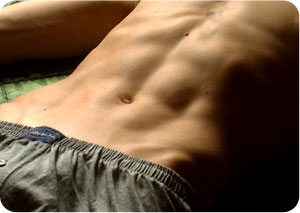Embarking on a journey towards a healthier, slimmer you? Let us guide you through one of the simplest yet most effective methods to lose that stubborn belly fat.
Walking, an activity so natural and accessible, has been proven to be an excellent way to shed those extra pounds. But it’s not as simple as just putting one foot in front of the other. There’s a science to it, a method to the madness, and we’re here to break it down for you.
In this guide, we’ll delve into the intricacies of walking for weight loss, providing you with all the necessary tools and knowledge to make your journey as efficient and effective as possible. So, lace up your shoes and get ready to step into a healthier future.

What Is Belly Fat?
Belly fat, also known as visceral fat, is a type of body fat that is stored within the abdominal cavity. It is located near several vital organs, including the liver, stomach, and intestines. This type of fat is different from subcutaneous fat, which is found just under the skin.
Belly fat is more than just a nuisance that makes your clothes feel tight. It’s seriously harmful and could be one of the reasons why you are having trouble losing weight despite walking regularly. This might be because belly fat is metabolically active and can produce hormones and chemicals that negatively affect your health.
Research shows that belly fat can increase the risk of type 2 diabetes, heart disease, and other health problems. Therefore, it is crucial to incorporate a walking loss guide into your daily routine to help reduce the amount of belly fat.
Walking is a simple, free, and easy exercise that can help you lose weight, especially around your middle. It can be done at any time of the day and can fit into any schedule, no matter how busy you are. A brisk walk for 30 minutes to an hour every day can burn calories and help you lose belly fat.
Remember, consistency is key. The amount of belly fat you lose will depend on the intensity, duration, and frequency of your walking workouts. So, lace up your shoes, hit the pavement, and start your journey towards a healthier, leaner you.
How Does Walking Reduce Belly Fat?
Walking is a simple, yet effective way to lose belly fat. It’s a low-impact exercise that can be easily incorporated into your daily routine. It’s not just about burning calories, but also about activating your metabolism and enhancing the fat-burning process.
When you walk, your body requires energy. This energy is derived from the stored fat in your body, including your belly. The more you walk, the more fat you burn. It’s that simple.
Walking also helps to balance your insulin levels. High insulin levels can lead to the accumulation of belly fat. Regular walking can help to stabilize these levels, preventing the buildup of belly fat.
Here are a few tips to maximize your belly fat loss through walking:
- Walk at a brisk pace: The faster you walk, the more calories you burn.
- Include interval training: Alternate between fast and slow walking to increase your calorie burn.
- Walk uphill: This increases the intensity of your workout, helping you burn more calories.
Moreover, walking is not only beneficial for reducing belly fat, but it also improves your overall health. It boosts your cardiovascular health, improves your mood, and reduces the risk of chronic diseases.
Remember, consistency is the key. Make sure to walk regularly and combine it with a balanced diet for optimal results. It’s not about quick fixes, but about making lifelong changes to your lifestyle.
Walking is a practical, inexpensive, and enjoyable way to lose belly fat. So, put on your walking shoes and take the first step towards a healthier you.
Can Walking Alone Eliminate Belly Fat?
Walking is a low-impact cardiovascular exercise that can indeed contribute to belly fat loss. It’s a convenient, accessible, and cost-effective way to kick-start your weight loss journey. However, it’s crucial to understand that walking alone might not be sufficient to eliminate belly fat completely.
Belly fat is stubborn and requires a multifaceted approach for successful reduction. This approach includes a balance of regular physical activity, healthy eating, and lifestyle modifications. Walking can certainly play a significant role in this process, especially when combined with a balanced diet rich in proteins, fibers, and healthy fats.
Walking helps in burning calories and improving metabolism, which are essential for weight loss. It can also help reduce visceral fat, the dangerous type of belly fat that surrounds your internal organs.
Here are some ways to make your walks more effective:
• Power walk: Increase your pace to burn more calories.
• Interval training: Alternate between fast and slow walking to increase calorie burn.
• Walk uphill: This will engage more muscles and increase calorie burn.
Remember, consistency is key. Make walking a part of your daily routine and gradually increase the duration and intensity of your walks.
It’s also important to note that everyone’s body responds differently to exercise. While some may see noticeable changes within a few weeks, others might take longer. Patience and persistence are essential in your belly fat walking loss journey.
Remember, walking is a step in the right direction, but it’s not a magic bullet to eliminate belly fat. It’s a component of a broader lifestyle change that includes healthy eating and regular exercise.
How Much Should I Walk Daily?
To effectively combat belly fat, walking is a proven, non-intensive method. The question of ‘how much should I walk daily’ is often asked by those looking to incorporate this exercise into their daily routine. The answer, however, isn’t a one-size-fits-all. It depends on various factors such as your current fitness level, weight, and overall health.
For beginners, it’s recommended to start with a manageable goal such as 30 minutes of brisk walking five days a week. This can gradually be increased to meet the American Heart Association’s guidelines of at least 150 minutes of moderate-intensity aerobic activity, like walking, per week.
The speed at which you walk also matters. A slower, leisurely pace might not burn as many calories as a brisk walk. Try to aim for a speed that makes your heart beat faster and leaves you slightly breathless, but still able to hold a conversation.
Remember, consistency is key. Make walking a part of your daily routine, whether it’s early morning, during lunch breaks, or in the evening. Use a walking loss guide to track your progress and stay motivated.
Walking is not only beneficial for reducing belly fat but also for improving overall health. It can help lower the risk of chronic diseases, improve mood, and boost energy levels. So, lace up your walking shoes and get moving!
- Start with a manageable goal
- Gradually increase your walking time
- Walk at a brisk pace for better results
- Consistency is crucial
- Use a walking loss guide to track progress
What Walking Speed Is Ideal For Fat Loss?
Walking is a simple, low-impact exercise that can aid significantly in your belly fat loss journey. The ideal walking speed for fat loss varies from person to person, but generally, a brisk walk of 3.5 to 4 miles per hour (mph) is considered optimal. This pace elevates the heart rate into the ‘fat-burning zone’, where the body utilizes stored fat for energy.
But why this speed? Well, at this pace, you’re walking briskly enough to elevate your heart rate, but not so fast that you’re depleting your energy reserves quickly. This balance allows your body to tap into stored fat for fuel, promoting belly fat loss.
Additionally, it’s worth mentioning that consistency is key. Regular, steady walks can lead to significant weight loss over time. Incorporating interval training, where you alternate between periods of fast and slow walking, can also boost your fat-burning potential.
Remember, it’s not just about the speed, but also the duration. Experts suggest walking for at least 30 minutes a day, five days a week.
- Walk at a brisk pace of 3.5 to 4 mph
- Consistency is key
- Include interval training
- Walk for at least 30 minutes a day, five days a week
Incorporating these strategies into your walking routine can help you maximize your belly fat loss. Remember, everyone’s body responds differently to exercise, so it’s important to listen to your body and adjust your pace accordingly.
Is Walking Better Than Gym For Belly Fat Loss?
Belly fat loss is a common fitness goal, and both walking and gym workouts can contribute to achieving it. However, the question arises: which is more effective?
Walking is a low-impact exercise, meaning it’s easier on the joints compared to high-intensity gym workouts. It’s also a form of aerobic exercise that can help burn calories and fat, including stubborn belly fat. Walking for weight loss can be easily incorporated into your daily routine, making it a sustainable choice for long-term fitness goals.
On the other hand, gym workouts often involve a combination of strength training and cardio, which can accelerate fat loss and improve overall body composition. High-intensity interval training (HIIT), a popular gym workout, is known to effectively target belly fat.
However, the effectiveness of both walking and gym workouts for belly fat loss largely depends on consistency, diet, and individual metabolic factors.
Walking for weight loss is a great option for beginners or those with joint issues. It’s also ideal for those who prefer outdoor activities or lack access to a gym.
Gym workouts, meanwhile, might be more suitable for those who desire quicker results and are able to commit to a more intense exercise regimen.
In summary, both walking and gym workouts can be effective for belly fat loss, and the choice between the two largely depends on individual preferences, fitness levels, and lifestyle factors.
Can Walking Replace Other Cardio Exercises?
Walking is a fantastic way to burn belly fat and lose weight. It’s a low-impact exercise that can be easily incorporated into your daily routine, making it an excellent option for those new to fitness or those with physical limitations. Walking can help you create a calorie deficit, which is vital for weight loss. Calorie deficit is when you burn more calories than you consume, leading to weight loss.
When considering if walking can replace other cardio exercises, it’s essential to understand the intensity. While walking is a great start, it may not provide the same calorie-burning benefits as higher-intensity cardio exercises like running or cycling. However, brisk walking can be just as effective as running in burning calories if done for longer durations.
- Walking is a low-impact exercise: This means it’s easier on your joints compared to high-impact exercises like running or jumping. It’s a great option for people with arthritis or other joint problems.
Brisk walking can also help improve your heart health, increase your lung capacity, and improve your overall fitness level. It’s an excellent option for those who prefer a less strenuous form of exercise.
Incorporating walking into your daily routine can be a simple way to start your fitness journey. However, for optimal belly fat loss, it’s best to combine walking with a balanced diet and other forms of exercise. Remember, there’s no one-size-fits-all answer when it comes to fitness, and what works best is what you can maintain in the long term.
While walking may not completely replace other cardio exercises, it’s a great place to start. It’s about finding the right balance and what works best for your lifestyle.
What Are Some Walking Techniques For Maximum Fat Loss?
Walking is an effective and accessible form of exercise that can help you lose belly fat. It is particularly beneficial when combined with a balanced diet. One technique to enhance fat loss is interval walking. This involves alternating between periods of fast and slow walking, which can help to increase your metabolic rate and burn more calories.
Another powerful technique is incline walking. This can be achieved by walking uphill or setting an incline on a treadmill. The added resistance helps to burn more calories and target belly fat.
Walking with weights is another technique to consider. Carrying light hand or ankle weights can increase the intensity of your walk, leading to a higher calorie burn.
Remember, consistency is key. Aim for at least 30 minutes of brisk walking most days of the week.
Interval walking, incline walking, and walking with weights are all effective techniques to maximize fat loss. However, it’s important to listen to your body and adjust these techniques as needed.
• Interval walking: Alternate between fast and slow walking for set periods.
• Incline walking: Walk uphill or set an incline on a treadmill.
• Walking with weights: Carry light hand or ankle weights.
Incorporate these techniques into your routine to help blast belly fat and improve your overall health.
Conclusion: Embrace Walking as a Powerful Tool for Belly Fat Loss
In summary, belly fat is an issue that many of us grapple with, but the solution might be simpler than we think. Walking, a low-impact exercise, has been proven to be effective in reducing belly fat. While it may not entirely eliminate belly fat on its own, when combined with a balanced diet and other forms of exercise, it can significantly contribute to fat loss.
The recommended daily walking duration varies, but a good starting point is around 30 minutes to an hour. Walking speed also plays a crucial role in fat loss, with brisk walking being the most effective. While gym workouts can be beneficial, walking often offers a more accessible and sustainable option for many.
Walking can be a great supplement to other cardio exercises, but it’s essential to employ the right techniques to maximize fat loss. Techniques such as interval walking can help increase calorie burn and fat loss.
As we move forward, the importance of walking for belly fat loss will only become more apparent. In a world increasingly focused on sedentary activities, incorporating regular walking into our daily routines is a simple yet effective step towards better health. So, lace up your shoes and take the first step towards a healthier you.

